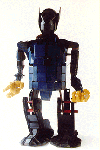
The Megabot robot series is a design for a muti-purpose Utility Robot. Its design is similar to a toy robot, but on a much larger scale. The design specifications call for the robots to be made of plastic and dense foam. There will be different models and they will range in height from 8 to 24 feet tall. Sensors will provide an array of interesting sounds and dazzling light effects.
Megabot Proto 1The Megabot Proto 1 was the first prototype of the Megabot series. It was constructed from recycled materials and off the shelf items. This robot demonstrates that robots can be built from very inexpensive materials like cardboard.Let's begin at the base. The oversized feet and legs are carved from corner strips of foam packing material using a razor blade. The leg pivot points rotate on PVC tubing, and turn inside bushings made of plastic tubing cut in short lengths, which are then sunk into the foam lower limbs and lower torso. Cardboard from pizza boxes and shipping cartons were used to reinforce these leg and foot parts. The cardboard is attached to the foam pieces with glue and sturdy toothpicks. The feet are modular and easily replaced . They are also constructed of foam but with are reinforced with a fiberglass coating. A cardboard covered foam wheel is embedded in the rear of each foot. Each wheel rotates on PVC tubing which also connects the foot to the lower leg bone and the forward lifting shin bone. A microswitch inserted into the bottom of each foot will be linked to a sound chip to produce mechanical sound and/or the activation of warning lights during foot movement. The lower torso houses the motor and battery power for the robot's movement. A battery operated socket wrench serves as the motor unit. A small bicycle gear welded to a 1.12 diameter socket turns a larger gear which then moves the offset rotating cam. The cam is constructed from PVC tubing. A small length of bicycle chain is also used. The gear box is currently constructed from layered and shaped cardboard which proved to be too weak and flexible to maintain the rigidity required to keep the gears apart. Stiffer cardboard or plastic coated cardboard could solve this problem as well as the flexing of the PVC and compression of the foam. The upper torso is made completely of cardboard and is easily removed and replaced with other upper torso designs. This robot is designed with a lot of modular components so that it can be easily changed. The head piece is a plastic helmet filled with foam, a battery pack and small lights. It is mounted on a PVC tube for side-to-side rotation. The foam neck section pivoted forward and backward. All this weight proved to be too much for the motor and gear box in the Megabot Proto 1. Plans were made to lighten the load for the second prototype.
Megabot Proto 2For Megabot Proto 2 (MP2), the robot design went almost entirely to a cardboard based unit. The legs and feet were constructed only of cardboard this time eliminating the heavier foam pieces. The cardboard material was cut and glued at right angles to add strength to the design. The motor and gear box unit were removed from the MP1 for use in this second version. No major modifications were made in the original design for these pieces.The upper torso again is completely cardboard. The hand and finger digits are carved foam with sturdy toothpicks for the pivot points. The digits can be manually positioned now but plans are to have them servo controlled. The head piece on the MP2 also went to the lighter cardboard version eliminating the plastic and foam from the first prototype. The MP2 head and arms are intended to be covered and eventually used for molds for mass production of the Megabot Army. Small servos could be adapted to move and control the head and arm pieces. This version of the Megabot, the MP2, successfully walked for a brief period in a test work session. The test walk proved that the design concept is good. Additional work is needed to replace parts where stronger materials are to be used for example in the gear box unit. In general all the high stress points on the robot should have stronger or plastic coated cardboard. The current robot shell on the MP2 is very impressive looking. The robot face appears to be an animal snout and the side profile shows pointed dog type ears on the head piece. The cardboard pieces were painted black and the eye socket areas are set back and painted red. The complete head piece gives the appearance of a space helmet for a robot dog. The leg and lower torso units are also painted black while the upper torso unit is blue. The PVC pieces are painted red and the foam pieces on the hand were painted yellow. Norman put over 1,000 hours of time into this project individually cutting and molding each of the pieces for the two units. In addition he did the design illustrations for the project. Glenn Currie also assisted in the design and work.
|